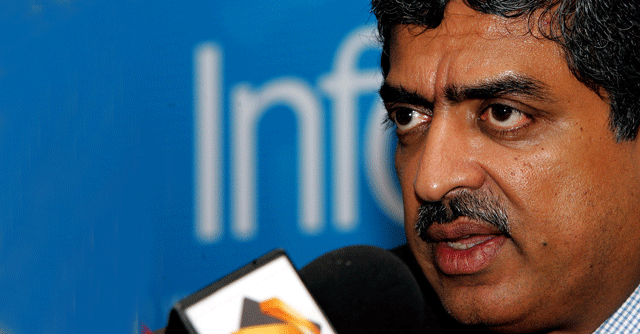
Digitisation can democratise lending in India: Nilekani

Digitisation of payments, in tandem with the adoption of Aadhaar across India, will lead to a steady democratisation of credit to small businesses and users in the country, said Nandan Nilekani, co-founder and non-executive chairman of Infosys. Speaking at the Mint Annual Banking Conclave, Nilekani shed light on how the adoption of Aadhaar can transform lending to make instant loans available for many more users.
“Aadhaar and UPI are helping transactional efficiency, migrating to high volume, low cost and small ticket-size transactions. This leads to expanding the market, as well as social inclusion. What these are now doing is also create a digital footprint. For example, when a small retailer sells or buys something digitally, there is a footprint of that transaction. Invoice details of digital purchases are uploaded automatically to the GST portal to file taxes. Hence, as more consumers and small businesses transact digitally, they create digital footprints,” Nilekani said.
These footprints, he said, have helped establish the Account Aggregator (AA) system in the country -- which was launched by the Reserve Bank of India in September 2021.
“What AA does is empower consumers and small businesses to get access to financial services. They can get their bank statements, GST, TDS and other data, and request an AA to securely share this with lenders. This process will dramatically democratise lending, as for the first time, this is removing the knowledge symmetry that is dissociated from small borrowers. They can borrow efficiently, quickly and at low cost -- in near real-time,” Nilekani said.
“Many banks are already embracing this, and I expect all banks to get on board,” he further added.
However, Nilekani added that to bring about this change, lenders must be prepared to switch to lower margins of operations. “You’d go from low volume, high cost and high value transactions to very high volume, very low cost and small ticket transactions. This is key to market expansion. You have to lower the transaction cost to be able to reach a wider set of people,” he added.
Talking about the AA model, Nilekani said that the use of artificial intelligence and Big Data can help bring more individuals as well as businesses into the fold of the formal economy. “Credit using data will fuel more consumption, as well as production. A lot of this will require Big Data and AI, as it’ll require sophisticated algorithms to figure out who is a deserving candidate, and who’s a fraud. We will hence see a big push on lending. This is part of a larger process of formalisation of the economy,” he said.

He also added that the scope of AA is wide, and is an already accepted model that awaits adoption. “AA is already approved by the Financial Stability and Development Council (of the Indian government’s Ministry of Finance), which treats all financial regulators. The first usage of AA may be with credit, but it will soon extend to personal finance, wealth management and so on.”
Nilekani also called upon service providers to build consumer-facing portals that are digital-first. “Consumerisation of the user experience is very important. As more people use smartphones and experience the ease of use of everyday apps, they will expect the same experience from financial services. If we are to attract and retain them, we have to give them an app as simple, intuitive and digital first as everything else.”
Finally, he also spoke about factors that banking providers in the digitisation journey should be aware of. “We will see a shift to the cloud, in combinations of public and private cloud models. This will require a whole new architecture of micro-services for banks to implement technologies quickly. Cyber security will be increasingly important -- as we expose more of our systems to the internet,” he said.
